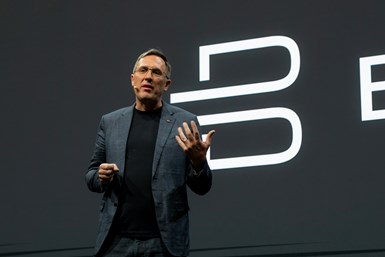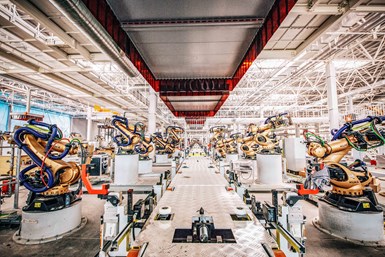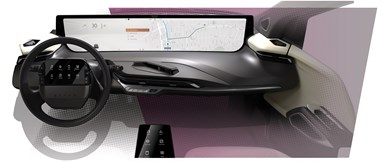What You Need to Know About Byton & the M-Byte
Byton is on a fast path forward with its M-Byte electric SUV launching in China this year and North America and Europe next. Here are key aspects. And keen insights from Benoit Jacob, its head of Design
#robotics
The Byton M-Byte all-electric SUV was something of a phenomenon when it was unveiled as a concept at the 2018 CES. Two years later, the China-based company brought the production vehicle of the vehicle to the stage at the Mandalay Bay Convention Center, showing that Byton is serious about bringing a real vehicle to driveways around the world in short order, something that other companies that have unveiled EVs over the past few years continue to put off to some point into the not-too-clear future.

The Byton M-Byte on display at the 2020 CES. Two years earlier, the concept was unveiled at the event. (Image: Byton)
Even though Dr. Daniel Kirchert, Byton CEO and co-founder, has continued to refer to the vehicle as a “next-generation smart device,” which sounds more like something you’d carry in your pocket rather than carry you and as many as four of your friends, the company has continued to accumulate investors and—in keeping with this smart device notion—content suppliers: not wholly unexpected ones, like AccuWeather and CloudCar (a voice-accessible source of cloud-based infotainment), but also surprising ones, like ViacomCBS, which will provide access to its TV brands via the Twine for Car system from ACCESS.

Byton CEO Dr. Daniel Kirchert: “The Byton M-Byte with its unique user experience will offer developers the opportunity to present in-car interactions in a way that is more engaging than ever before.” (Image: Byton)
Building M-Byte
One way to know and understand the seriousness of this undertaking is this: They started building a factory in September 2017. This factory is building vehicles.
The Byton factory—an 800,000-m2 facility—is located in the Nanjing Economic and Technological Development Zone in Jiangsu Province. The investment for the facility, which the company says is predicated on Industry 4.0 protocol, is on the order of $1.5 billion U.S.

There are 335 KUKA robots in the Byton weld shop. (Image: Byton)
This is a fully integrated operation including stamping, welding, painting, assembly and battery operations. The facility, at full capacity, will be able to produce 300,000 vehicles per year. (There are plans for other EVs, not just the M-Byte, which explains the capacity.)
According to Byton, the stamping shops produce panels at a rate of one every three seconds, making it one of the fastest automotive stamping plants in China.
The welding shop has 335 KUKA welding robots.
The paint shop utilizes an array of technology from Dürr Systems that reduces the overall footprint by approximately 20%. The equipment includes:
- RoDip, a rotational body dip process for pretreatment and electrocoating
- EcoDC MACS, which uses modular anode control to create a voltage profile in the RoDip tank that moves along with the body to provide energy savings
- EcoBell 3 atomizer bells on the robots
- EcoDryX dry separation system to separate overspray in the paint booths for primer and top coat
- EcoInCure, a system that dries the bodies by heating them from the inside with heated air applied through nozzles which allows more uniform heating (as well as the ability cure mixed material structures; the M-Byte uses both steel and aluminum)
The battery shop assembles the battery packs. The battery modules are being supplied by CATL (although it is known by its acronym, its full name is: Contemporary Amperex Technology Co. Limited). The aluminum battery tray is being produced for BYTON by Constellium.
About the M-Byte
The M-Byte SUV measures 192 inches long with a 116-inch wheelbase. It is 78 inches wide (without mirrors) and 66 inches high. Depending on the version—there are both rear-wheel drive and all-wheel drive configurations available, with the RWD version having a single 200-kW rear-mounted electric motor and the AWD having an additional for a total output of 300-kW—the vehicle weighs from 5,104 to 5,732 pounds. There are also different lithium-ion battery packs available, either 72 or 95 kWh, which also accounts for mass differences.
(Speaking of batteries, Byton is partnering with Electrify American for DC fast charging, which will allow the vehicle to get a charge that translates to 150 miles in 30 minutes. The M-Byte also has the capacity for AC charging at home.)
Award-winning Design
The production M-Byte received a prestigious iF Design award this past May—before the vehicle was on the road. According to the jury, “Both the exterior and the interior are defined by pure product design without emotional overload.”
And they also noted, “The user experience goes into new dimensions for operating the car. Precise lines and surfaces lead the eye to understand the new inner values of Byton’s M-Byte and avoid the fear of a technical barrier. Great comfort and the absence of superfluous gimmicks make this new model absolutely trustworthy.”

As this rendering shows (using a rendering rather than an actual photo as it is easier to discern each element) there is the 48-inch screen, a seven-inch tablet in the steering wheel for the driver and an eight-inch touchpad between the front seats. (Image: Byton)
That last comment may be looked at with a bit of wonder in as much as what one ordinarily considers to be the instrument panel—including the gauge cluster and the infotainment head unit—is on the M-Byte a 48-inch “Shared Experience Display” that goes from A-pillar to A-pillar. (It is also referred to by Byton as the “Stage Display” because it does have something of a theatrical aspect to it not seen in other vehicles.)
And on the subject of interior technology, the vehicle also has a seven-inch driver tablet in the steering wheel and an eight-inch touchpad between the driver and front passenger.
Deeply into the Design
Benoit Jacob is the senior vice president of Design at Byton. He came to the company from BMW, where he’d been the lead designer at BMW i, the sub brand of BMW dedicated to plug-in vehicles (e.g., the i3 plug-in EV and the i8 plug-in hybrid). The graduate of Art Center College of Design—in Vevey, Switzerland, not Pasadena—Jacob had spent time working at Renault (he is French) and Volkswagen Group prior to joining BMW in 2003. He joined Byton in 2016.

Benoit Jacob is the senior vice president of Design at Byton. (Image: Byton)
Here are some of his observations about bringing the M-Byte from concept to production.
On clarity and realism of vehicle design
“We had relatively clear and realistic targets for the concept. The concept was not meant to be something that we could not deliver. When we were doing the concept we were thinking of what we could provide for real.”
On where to innovate
“The only way you can bring innovation to a vehicle”—and here he nods to the 48-inch display—“is at a price point. You can’t have innovation everywhere. So some of the technologies are fairly conventional. For example, it is a classic body-in-white. We only innovated in the places where we thought we could make a difference.”
On why the M-Byte looks like an SUV
“We are aiming at relatively high volumes and three different markets. It has to appeal to different cultures and tastes. I wouldn’t say that it is mainstream. It is modern. It has good proportions. We didn’t want to do something that bends classical car design rules because that isn’t what is being asked for by customers. They are not looking for a fancy new design. They are looking for something that is clean, connected and safe. Not only in the physical sense, but digitally as well.”
On regulations
“The car is designed to meet world regulations—crash, pedestrian. They dictate some of the proportions. You can’t just design something with a piece of glass in front of the whole thing.”
On EVs as the new normal
“We consider electric mobility to be the new normal. We don’t need to make it over-the-top and too fashionable.”
On the issue of fashion
“Remember shoulder pads? Maybe they were fun the first year, but by the second year, everyone was fed up with them. We are talking about sustainability—people are going to be able to update the vehicle over its life. So we don’t want the design to be too fashionable.”
On answering the key questions
“When I talk to family or friends about electric cars it is always the same. What is it so expensive, why is the range limited and why is it so ugly? We are answering these basic questions.”
On what it needs to do
“Even if we describe it as a ‘smart mobility device’ and even if it can do many more things than a regular vehicle, it is still a car. You have to sit in line with the direction of the driving because of regulations. With the flat floor we can free up more space. We can integrate the display. It is truly different. But you’re still inside a car. It’s not like a lot of concepts that are showing living rooms on four wheels. To get to that we’d need to be talking about a different transportation system.”
On what’s next
“I’m interested in the next generation of vehicles that will hopefully be radically different. But we have to go through a transition period. The law makers are not going to allow all of those fancy show cars with seats facing each other. It is very cool for the designers. And these are not difficult ideas to have—you can find them in any design studio. But are you going to be able to prove they’re safe? But from then we might go into really radially different types of vehicles. But they’ll not be for everyone.”
On how he sees his job
“It is not about my taste. My role as a designer is to serve a business and society. You have to have meaningful answers. I’ve done enough cars so I don’t have to do my manifesto, my design. I tasked the team: A good-looking car. That’s what people want.”
RELATED CONTENT
-
on lots of electric trucks. . .Grand Highlander. . .atomically analyzing additive. . .geometric designs. . .Dodge Hornet. . .
EVs slowdown. . .Ram’s latest in electricity. . .the Grand Highlander is. . .additive at the atomic level. . .advanced—and retro—designs. . .the Dodge Hornet. . .Rimac in reverse. . .
-
On Ford Maverick, Toyota Tundra Hybrid, and GM's Factory Footprint
GM is transforming its approach to the auto market—and its factories. Ford builds a small truck for the urban market. Toyota builds a full-size pickup and uses a hybrid instead of a diesel. And Faurecia thinks that hydrogen is where the industry is going.
-
On The Jeep Grand Cherokee, 2022 Nissan Pathfinder, and More
An inside look at the Detroit Assembly Complex-Mack; a innovative approach to waste-free, two-tone painting; why a forging press is like an F1 car; and other automotive developments.


.jpg;width=70;height=70;mode=crop)






